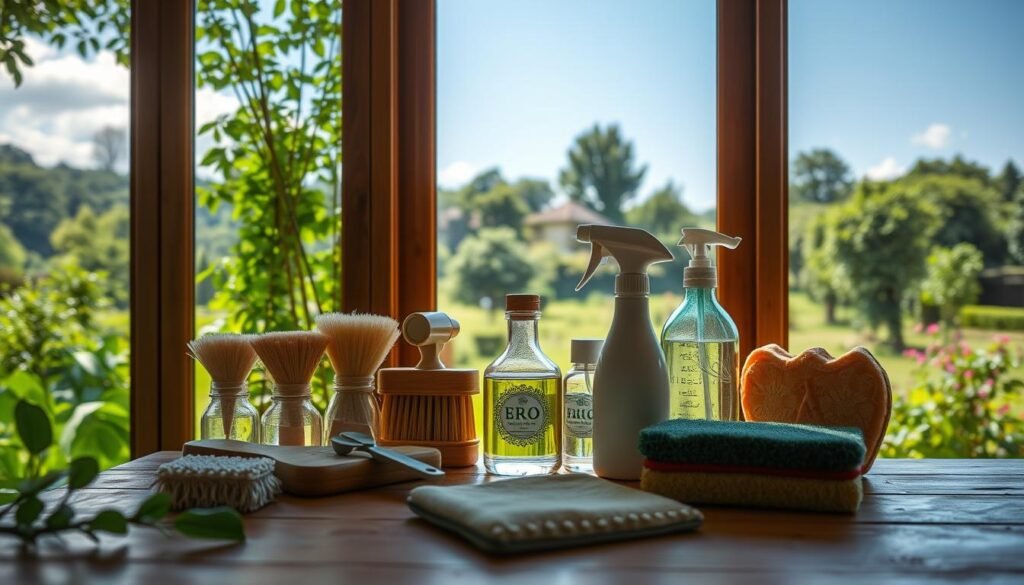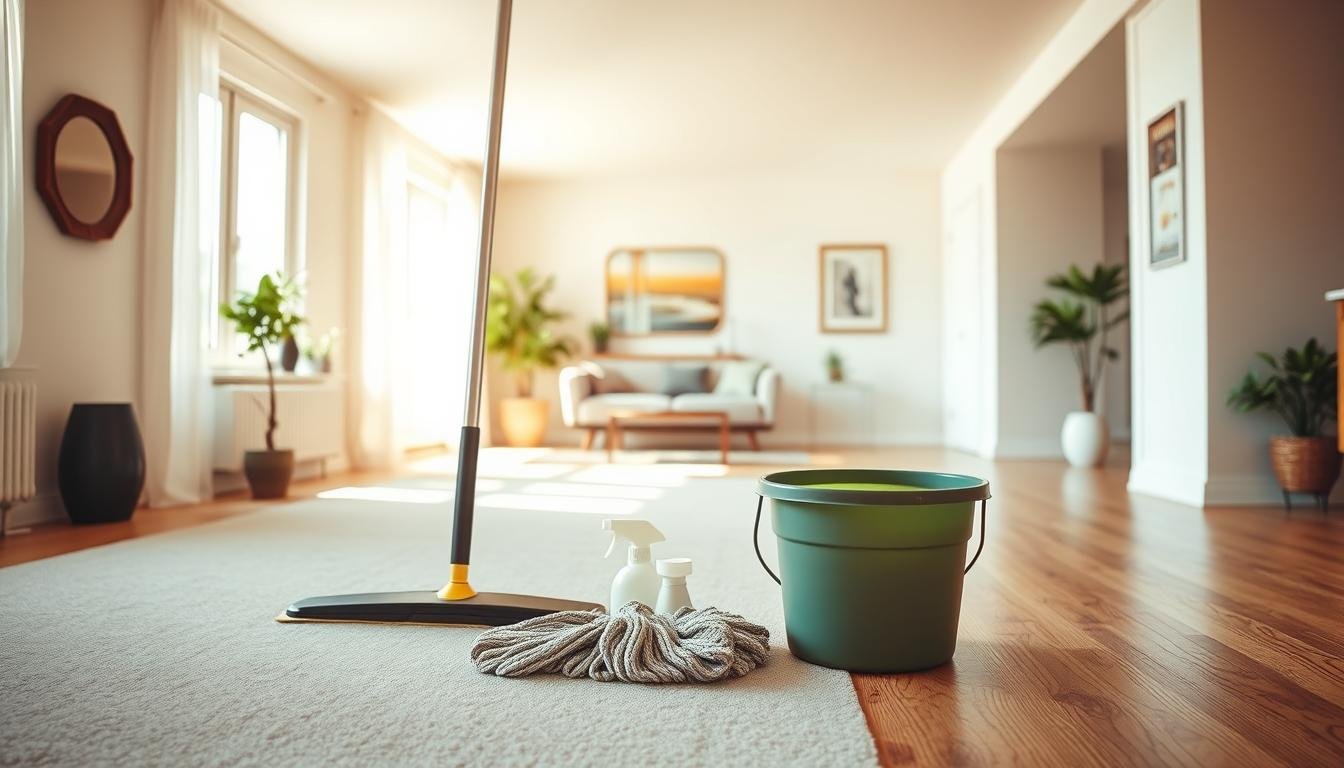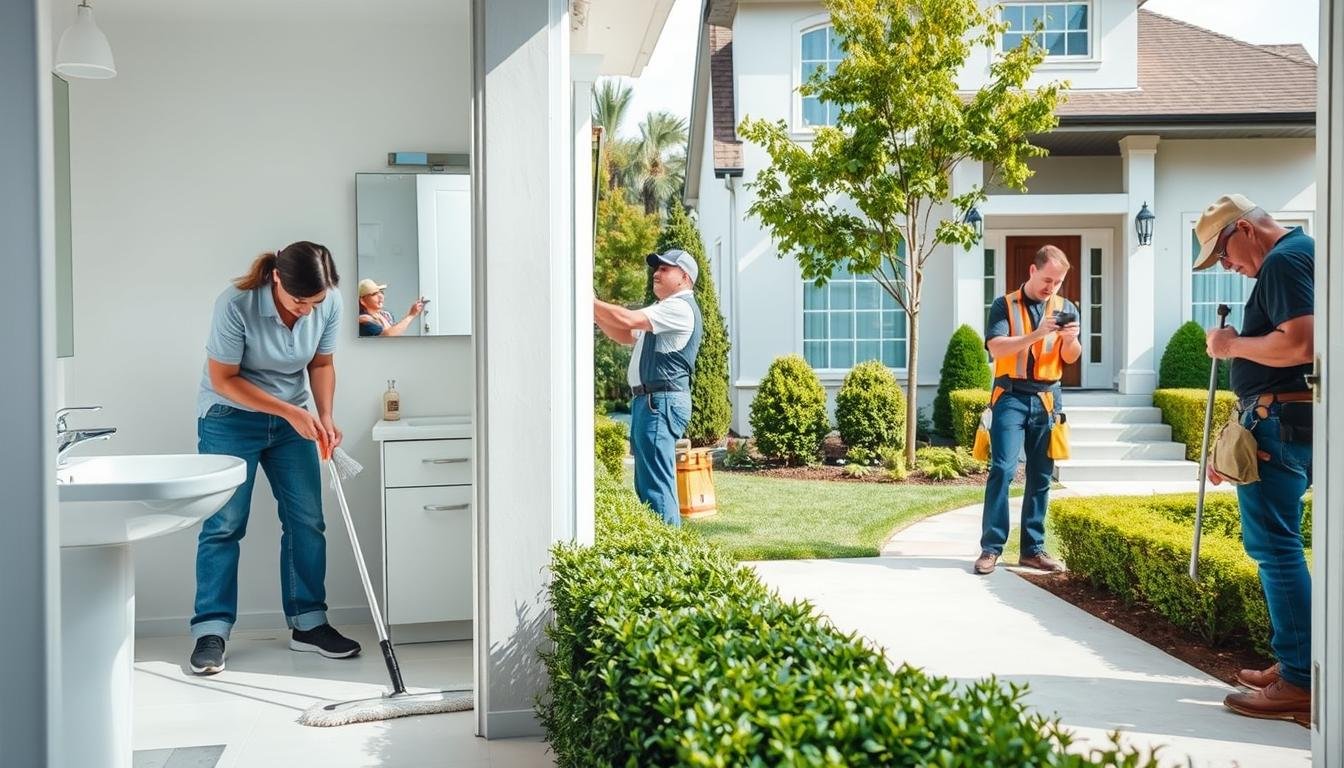Today, we have modern tools like washing machines2. But the goal of keeping homes clean has always been the same.
These old ways of cleaning show how much work has been reduced. Now, we have easier ways to clean. But, we’re also seeing a return to eco-friendly cleaning methods.
Key Takeaways
- Cleaning through the ages shows how technology transformed domestic work.
- Historical cleaning methods prioritized health, like ancient Greek “katharsis”1.
- Housekeeping history reveals gender roles through tasks like weekly laundry cycles2.
- Modern conveniences like washing machines replaced multi-step hand-washing processes2.
- The evolution of cleaning practices mirrors societal progress in science and labor efficiency.
The Dawn of Cleanliness: Ancient Cleaning Practices
Early civilizations knew household hygiene in history was key to health and culture. They built drainage systems and planned cities, creating tools like reed brooms and clay pots. Traditional housecleaning strategies linked cleanliness to survival and spirituality3.
Early Civilizations and Their Sanitation Methods
The Babylonians made soap from animal fat and ashes around 2800 B.C., a big step in ancient housekeeping practices3. Egyptians used papyrus stalks to sweep, and Romans built lead pipes for waste. The Etruscans built sewers in Rome by 500 B.C., showing how origins of domestic sanitation mixed engineering and tradition3.
Egyptian and Roman Bathing Rituals
Egyptians bathed with natron crystals and perfumed oils, linking cleanliness to religion. Roman ancient housekeeping techniques included public baths with steam rooms and historical methods of housekeeping like cleaners made from urine. These cleaners were ammonia-rich and used for laundry and teeth, showing early traditional cleaning habits4. Roman baths were social places, mixing hygiene with fun.
Natural Cleaning Substances in Antiquity
Greeks cleaned with olive oil and strigils. Egyptians used vinegar and water, and Romans polished with pumice. These traditional cleaning techniques used plants, minerals, and animal products, showing nature’s role in household cleanliness through time3.
Medieval Housekeeping: Myths and Realities
Housekeeping in different eras often involved creative solutions to daily challenges. Medieval households lacked modern tools, but they were very resourceful. For example, Romans used linen sudaria for dining, and by the 16th century, napkins showed social status5. Yet, myths about filth ignore the real challenges faced by class and resources.
Household chores in the past included bathing sparingly due to beliefs that water could harm health6. Medical texts like Trota of Salerno’s 12th-century writings advised washing with wine and herbs6. Kings like Edward III upgraded bath facilities, installing heated water systems7, while peasants used rivers, risking drownings like the 12-year-old in 12696.
“Napkins must not touch the nose,” warned a 1729 French guide, reflecting evolving etiquette5.
Cleaning through different time periods saw innovation clash with tradition. While 30-50% of Europeans died in the Black Death due to poor sanitation7, practices like using ash for laundry persisted. Even today, brands like Stalbridge Linen Services draw from these historical methods5. Housekeeping in the past was far from static—adapting to beliefs, resources, and social norms.
Renaissance Homes: Evolving Standards of Cleanliness
In the Renaissance, household chores throughout history changed a lot. Cleanliness became a sign of wealth. Rich families had big teams for housekeeping traditions. Poor families did it all by themselves.
- Weathly households employed specialized staff: chambermaids, laundresses, and scullery maids9.
- Improved soap production and chimney designs reduced indoor soot, advancing historical home maintenance practices.
- Public health movements post-19th century linked cleanliness to disease prevention8, boosting demand for better historical cleaning techniques.
In the 1800s, household cleanliness throughout history made big leaps. Indoor plumbing and germ theory came along. But, these changes came slower to rural areas8. Today, homes mix old ways with new tech.
Colonial American Housekeeping Traditions
Housekeeping in Colonial America changed based on where people lived. In New England, people followed Puritan values of order and thrift. They cleaned floors with sand and lye soap.
In the South, big plantations used slaves to keep homes clean. Out west, families made their own soap and cleaners from herbs. These ways of cleaning show how historical housekeeping techniques fit local needs and what was available10.
Cleaning changed with the seasons. In spring, homes were cleaned to get rid of winter dirt. Fall was for food preservation and winter prep.
Summer was hard because of bugs, and winter was tough with less to clean. Cleaning was often a community effort, helping neighbors and building bonds10.
People made their own cleaners from what they had. They used ash for soap, vinegar for windows, and rosemary to clean the air. Recipes from old books like Susanna Whatman’s 1776 Housekeeping Book helped keep these traditions alive. They show how historical house cleaning techniques were both practical and creative10.
| Region | Cleaning Focus |
|---|---|
| New England | Ash soap, weekly hearth maintenance |
| South | Enslaved labor managing large estates |
| Frontier | Animal fat candles and plant-based dyes |
| Southwest | Pueblo clay for scrubbing, herb-based air fresheners |
These traditions highlight how house cleaning trends throughout the ages were influenced by environment and society. From making butter by hand to using rag cloths, each tool had a story of survival and adaptation10.
The Victorian Cleaning Revolution
The Victorian era (1837–1901)11 saw big changes in housekeeping throughout history. Cities grew, bringing coal soot and crowded homes. Middle-class families used vintage cleaning practices and new tech.
Cleaning agents included odd items: white bread for walls and skim milk for floors11. These methods mixed old ways with new efficiency.
| Traditional Methods | Victorian Innovations |
|---|---|
| Baking soda for scrubbing | Mechanical vacuum cleaners |
| Hand-washed laundry | Early washing machines |
| Olive oil for furniture | Chemical-based cleaners |
Today, some traditional cleaning methods like vinegar or lemon juice come from this time.
Cleaning Through the Ages: A Historical Look at Housekeeping

Housekeeping has always shown what a society values. In ancient times, like Egypt and Rome, cleanliness was tied to spiritual purity13. This idea has changed over time, showing how cleaning is more than just a task.
How Cultural Values Shaped Cleaning Practices
What was considered “clean” varied by culture. Ancient Egyptians used natural cleaners like natron13. By the 18th century, Enlightenment thinkers linked cleanliness to being moral. Today, we see how cleaning choices reflect our cultural values.
Gender Roles and Domestic Responsibilities
The Impact of Social Status on Household Cleanliness
Being wealthy meant having better cleaning tools. In the Victorian era, the rich had many servants14. Today, who can afford professional cleaning shows economic differences.
| Time Period | Cultural Values | Gender Dynamics | Social Status |
|---|---|---|---|
| Ancient | Rituals and purity (kkk1) | Shared tasks | Wealthy had infrastructure |
| Victorian | Morality-driven (source note) | Women’s domain | Servants for elites (kkk2) |
| Modern | Convenience and efficiency | Gender gap persists (kkk3) | Professional services for all |
Housekeeping’s history shows how culture, gender, and class have always mixed. From ancient rituals to today’s smart vacuums, cleanliness has always been a way to show who we are.
The Evolution of Cleaning Tools and Technologies
From handmade brooms to smart robots, the evolution of cleaning tools shows centuries of creativity. Early methods like beating rugs outdoors were replaced by historical cleaning tools that changed housekeeping. These cleaning tools throughout the ages made tasks easier and changed how we manage chores.
“The first vacuum cleaners emerged in the 1860s as hand-operated devices needing two people to function16.”
- 1860s: Manual vacuums required teamwork16
- 1900s: Electric washersines cut laundry time
- 20th century: Dishwashers and disposals units simplified kitchen chores
Kitchens changed with historical cleaning methods like wooden surfaces replaced by linoleum and stainless steel. These changes needed new cleaning tools and techniques in the past to meet new standards. As housekeeping history shows, every innovation changed our cleaning ways—from traditional cleaning practices to today’s automated systems. The evolution of cleaning techniques keeps moving, balancing old ways with new efficiency.
World Wars and Their Impact on Domestic Cleaning
War changed home life a lot. During WWI and WWII, there were shortages and changes in who worked. Families reused things like soap, and women went to factories, leaving less time for cleaning. Governments told people that keeping homes clean was a way to support the war effort.
“A clean home is a victory for our troops!”
Messages like this made cleaning seem important for the war. With servants away, families had to clean on their own using old ways. For example, in Britain, fewer people worked as servants after WWI, making families do all the cleaning themselves18.
But, the wars also brought new ideas. Synthetic detergents, first used by the military, became common in homes. This change showed how cleaning methods evolved from hard work to easier solutions. After the wars, more people moved to suburbs, leading to a need for appliances that save time19.
These changes were part of bigger shifts. By 2015, women were spending twice as much time on household chores as men19. Wars helped bring in new technologies and ways of thinking about cleaning. From using less to needing more, these years changed how we clean our homes today.
Mid-Century Modern: The Rise of Convenience Cleaning
The mid-20th century saw big changes in modern housekeeping techniques. Chemical cleaners like synthetic detergents replaced old soaps, making cleaning easier21. Brands like Lysol and Mr. Clean claimed their products were better than the old ways22. Ads pushed for spotless homes, making homemakers feel they had to keep up21.
Marketing tied house cleaning trends to suburban dreams. Tupperware parties made homemakers sales agents, mixing work and home22. Ads like the “Kitchen Debate” showed American housekeeping traditions as signs of progress21. This time changed history of housekeeping, mixing convenience with new social hopes.
The Green Cleaning Movement: Returning to Traditional Wisdom
The green cleaning movement is changing how we clean. It brings back old ways to make homes healthier. Modern eco-cleaning mixes old habits with new technology, focusing on safe cleaning.

- Vinegar’s acetic acid fights bacteria and mineral buildup.
- Baking soda’s mild abrasiveness lifts stains without harsh chemicals.
- Essential oils like lemon and tea tree add scent and antimicrobial power.
Today, 79% of U.S. consumers want eco-friendly cleaning products, but only 41% actually use them24. This shows a gap between what people want and what they do. Plant-based products are becoming more popular, backed by science that supports old natural cleaners like lavender and citrus.
“93% of U.S. carbon emissions from personal care products stem from consumer use,” according to Unilever’s Sustainable Living Plan.
Using both old and new methods is key. Tools like microfiber cloths and energy-efficient appliances help. Sustainable home maintenance now combines history with new ideas, like concentrated detergents that reduce plastic waste. As the green cleaning movement grows, more brands offer safe cleaning options, showing natural cleaners can be as good as synthetic ones.
With over 77% of Americans wanting sustainable choices24, the movement is pushing for change. By choosing eco-friendly housekeeping, homes can be safer for people and the planet. This shows sustainable cleaning is here to stay.
Digital Age Housekeeping: Smart Homes and Robotic Cleaners
The rise ofsmart home cleaningsystems has changed our daily lives. Robotic vacuum cleaners are now in 30% of U.S. homes, with more people getting them every year25. These smart devices, like iRobot’s Roomba, learn the layout and clean on their own. This saves a lot of time on cleaning.
But it’s not just vacuums. Smart sensors check the air quality, and apps help plan cleaning tasks. AI in home maintenance systems even adjust cleaning based on how much you use them. This makes cleaning up to 20% more efficient25. Over 67% of users say these tools save them a lot of time, making them a top choice for busy families26.
New tech like automated window washers and self-mopping floors show the future of housekeeping. The market for these technological cleaning innovations could reach $15 billion by 2025. But, only 40% of homes use these tools, showing a gap in access25.
Despite the hurdles, the benefits are clear. Smart thermostats can save 20-30% on energy bills, and robotic tools make cleaning windows 50% easier25. As modern cleaning technology keeps improving, it aims to make our lives easier while staying true to values like sustainability and fairness.
Conclusion: Lessons from Housekeeping History for Modern Homes
Looking back at housekeeping history shows how cleaning practices have changed over time. Early methods, like using rhubarb for rust or cucumber for pests, highlight the value of simple, green solutions27. These old-school cleaning tips are making a comeback in today’s green cleaning movement, inspired by Susanna Whatman’s 1776 guide27.
From ancient cleaning methods to modern tech, our goal is the same: to create healthy, functional spaces. By combining timeless cleaning wisdom with today’s technology, we pay tribute to the past while making our homes better. Every cleaning task connects us to those who came before us, all striving for a clean, comfortable home27.
FAQ
What are some of the oldest known cleaning practices in history?
Ancient civilizations in Mesopotamia and the Indus Valley started cleaning early. They built drainage systems and had communal cleaning areas around 4000 BCE. This shows they knew cleanliness was key to health.
How did bathing rituals evolve in ancient civilizations?
Egyptians and Romans valued bathing a lot. Egyptians used natron and oils for cleaning, while Romans had public baths. These baths were social spots, showing bathing was more than just cleaning.
What natural substances were used for cleaning in ancient times?
Ancient people used plants like saponin-rich ones, vinegar, and lemon juice. They also used clay and pumice. This shows they were smart about cleaning with what they had.
Were people in the Middle Ages as dirty as commonly believed?
No, medieval people had their own cleaning standards. Monks kept Roman bathing traditions alive. Even in tough times, people used natural cleaners to stay clean.
How did cleaning practices change during the Renaissance?
The Renaissance made cleaning more complex. Rich homes had big cleaning teams, while the middle class showed off their cleanliness. New jobs like housekeepers and chambermaids appeared, showing the complexity of home life.
What innovations occurred in cleaning tools and methods during the Victorian era?
The Victorians saw cleanliness as a moral issue. They invented the first carpet sweepers and washing machines. Middle-class homes faced new cleaning challenges due to their size and cleanliness standards.
How did the World Wars impact domestic cleaning practices?
Wartime shortages led to creative cleaning solutions. Women working outside the home changed household routines. They saw hygiene as a patriotic duty.
What is the significance of the green cleaning movement today?
The green cleaning movement focuses on natural cleaning methods. It addresses health and environmental concerns of synthetic chemicals. Traditional methods are coming back as people choose eco-friendly options.
What role does technology play in modern housekeeping?
Technology, like robotic cleaners and smart home devices, is changing housekeeping. It makes cleaning more efficient and helps monitor cleanliness. It also changes how tasks are divided in the home.




